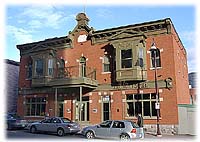The Bank Hotel
14 Eddy Street

Philemon Wright bequeathed this land to his son Tiberius, who gave it to his son (or grandson) Philemon, who passed it on in 1874 to his niece Janet Louisa Scott. In 1885, shortly before her marriage, Janet sold it to her mother, Nancy Louisa Wright, widow of John Scott. When Nancy died in 1901, Janet regained what her uncle had left her, as well as other bequests from her mother.
In April 1907, Joseph-Napoleon Fortin and Joseph-Éphrem Gravelle rented a portion of Lot 693 from Janet Louisa Scott for ten years with the intention of building the Bank Hotel there. This was not their first joint venture. Fortin, born in 1843, had moved to Hull after 1872. In the late 1880s or early 1890s, he had joined with his future son-in-law Gravel, born in 1864, in the lime business, and then a phosphate mine, a material used in their mica factory in Hull. Both were involved in several activities in the Hull community besides municipal politics. Fortin was Alderman for District 3 three times, between 1895 and 1904, and Gravelle represented District 2 from 1908 until 1911. The term of office for an alderman was two years at that time.
Fortin and Gravelle were also in the hospitality industry. Before 1884, Fortin already had a tobacconist's shop in the Scott block, located on Main Street (du Portage), between Eddy and St-Jacques. With his partner, he added a billiard room. The partners also owned the Hub Saloon, situated farther along on Main Street. At the turn of the century, they bought land on the southeast corner of Main and Bridge (Eddy), where they built a house and the Office Hotel. Shortly after selling this property to the Bank of Montreal, they built the Bank Hotel.
In 1907, Fortin and Gravelle hired Hull architect Charles Brodeur to build a new hotel on Bridge (Eddy) Street, behind their smoke shop. The contractor was Christie Lynott, a specialist in bank and hotel furnishings and ornamental sculpture. The foundations were entrusted to another contractor, Joseph Benoît. As the construction was going on at the same time as that of the Bank of Montreal nearby, Fortin and Gravelle asked Benoît to retrieve the bricks from the house on the site of the future Bank of Montreal and to use them for land fill. Completed in 1908, the neo-Queen Anne style Bank Hotel is considered one of the most beautiful buildings in the city. Between 1908 and 1915, the two businessmen installed a door between the hotel and the smoke shop-billiard hall, and added bedrooms to the first floor of what was the Scott Building.
The hotel was built at a time when the Hull Temperance Society exercised considerable influence. In 1908, the Society managed to decrease the number of establishments authorized to sell alcohol from 21 to 15. In May 1911, it obtained a reduction in the opening hours of licensed hotels. Although the Society applied increased pressure to eradicate the sale of alcohol, customers continued to flock to Hull as prohibition (1919-1933) was in force everywhere in North America except Quebec.
In October 1916, Gravelle and Fortin bought the land on which the hotel stood, and sold it, with the building and the liquor license, to John P. Coulson of Sudbury, Ontario. A month later, Coulson and his Sudbury partner transferred the business to their company, the Bank Hotel Company. The mortgage in favour of Fortin and Gravelle was converted to shares in the Bank Hotel Company, and they remained shareholders until their death. In 1931, other shareholders and administrators of the company included Hull merchant Alexis Carrière, President, and A. Sévigny, Secretary. Two years later, Joseph Barnabé's signature appears on the minutes. Finally, from 1953 to 1960, J. D'Arcy Coulson was president of the company and Howard St. George was Vice-President and Secretary-Treasurer.
The Bank Hotel Company managed the hotel for 43 years, from December 1916 to October 30, 1959, when the establishment was sold to Albert Poirier. Following his death on May 29, 1985, the hotel became the property of his wife, Régina Carrière. In 1998, his son, André Poirier, obtained a licence to restore the building, which was classified by the City as a historic monument.
|